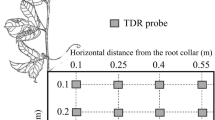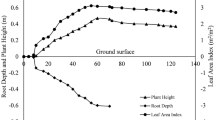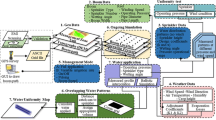Abstract
Subsurface soil acidity reduces the growth of roots, which can potentially decrease crop yields. However, the magnitude of these yield reductions is dependent on interactions between factors such as the depth and severity of subsurface soil acidity, plant resistance to acidity, and water and nutrient availability. The Agricultural Production Systems Simulator (APSIM) was used to examine effects of these factors and their interactions on wheat yields in the Mediterranean climatic regions of Western Australia. The model was linked to historical meteorological data of the region (up to 90 different seasons), and was run for three locations representing low, medium and high rainfall zones and three constant but contrasting soil acidity profiles in a deep sandy soil with two wheat cultivars differing in aluminium (Al) resistance. The simulated results showed inherently high variability between seasons in grain yield, rooting depth and nitrogen leaching. Subsurface soil acidity could decrease average grain yields by up to 60%, particularly in soil profiles with acidity in deep layers. The adverse effects of acidity on wheat yields were greater in the high than the low rainfall zone. Amelioration of acidity by 75% in the entire profile or in the top 20-cm layer improved the yield of the Al-sensitive wheat cultivar. Growing Al-resistant wheat partially eliminated the negative effects of acidity on yields in soils with severe subsurface acidity and almost fully eliminated these negative effects in soils with moderate subsurface acidity. The yield benefits arising from growing Al-resistant wheat were greater than those from ameliorating acidity in the 0–20 cm layer by liming. Increasing nitrogen input increased yields of both Al-sensitive and Al-resistant wheat grown in acid soils in all the rainfall zones, but the yield increments were much greater in the high than the low rainfall zones. Applications of nitrogen fertilisers mitigate the effect of acidity on yields of Al-sensitive wheat in soils with shallow (10–40 cm) subsurface acidity. Furthermore, the improved yield by growing Al-resistant wheat and amelioration of acidity was correlated with increased rooting depth and was associated with decreased nitrogen leaching. Possible agronomic management options to combat the subsurface acidity problem are discussed.
Similar content being viewed by others
References
Anderson G C, Fillery I R P, Dolling P J and Asseng S 1998 Nitrogen and water flows under pasture-wheat and lupin-wheat rotations in deep sands in Western Australia. 1. Nitrogen fixation in legumes, net N mineralisation, and utilisation of soil-derived nitrogen. Aust. J. Agric. Res. 49, 329–343.
Asseng S, Fillery I R P, Anderson G C, Dolling P J, Dunin F X and Keating B A 1998a Use of the APSIM wheat model to predict yield, drainage, and NO3-leaching for a deep sand. Aust. J. Agric. Res. 49, 363–377.
Asseng S, Keating B A, Fillery I R P, Gregory P J, Bowden J W, Turner N C, Palta J A and Abrecht D G 1998b Performance of the APSIM-wheat model in Western Australia. Field Crops Res. 57, 163–179.
Asseng S, Fillery I R P, Dunin F X, Keating B A and Meinke H 2001a. Potential deep drainage under wheat crops in a Mediterranean climate. I. Temporal and spatial variability. Aust. J. Agric. Res. 52, 45–56.
Asseng S, Turner N C and Keating B A 2001b Analysis of waterand nitrogen-use efficiency of wheat in a Mediterranean climate. Plant Soil 233, 127–143.
Barton L and Carr S J 1996 Development and verification of a quick test for the diagnosis of aluminium toxicity on the deep yellow earths of Western Australia. Aust. J. Soil Res. 34, 781–788.
Bushamuka V N and Zobel RW1998 Maize and soybean tap, basal and lateral root responses to a stratified acid, Al-toxic soil. Crop Sci. 38, 416–421.
Carr S J 1992 Development of a Soil Test for the Diagnosis of Subsoil Aluminium Toxicity in Yellow Earths in Western Australia. PhD Thesis, The University of Western Australia, Australia, pp. 192.
Carr S J, Ritchie G S P and Porter W M 1991 A soil test for subsurface soil aluminium toxicity in the yellow earth soils of Western Australia. Aust. J. Agric. Res. 42, 875–892.
Dolling P J, Porter WM and Robson A D 1991 Effect of soil acidity on barley production in the south-west of Western Australia. 2. Cereal genotypes and their response to lime. Aust. J. Exp. Agric. 31, 811–818.
Doss B D and Lund Z F 1975 Subsurface soil pH effects on growth and yield of cotton. Agron. J. 67, 193–196.
Foy C D 1992 Soil chemical factors limiting plant root growth. Adv. Soil Sci. 19, 97–149.
French R J and Schultz J E 1984 Water use efficiency of wheat in a Mediterranean-type environment. I. The relation between yield, water use and climate. Aust. J. Agric. Res. 35, 743–764.
Helyar K R 1991 The management of acid soils. In Plant–Soil Interactions at Low pH. Eds. R J Wright et al. pp. 365–382. Kluwer Academic Publishers, Dordrecht, The Netherlands.
Keating B A, Meinke H, Probert M E, Huth N I and Hills I G 1997 NWheat: Documentation and performance of a wheat module for APSIM. Tropical Agronomy Technical Memorandum, CSIRO Division of Tropical Agriculture, St Lucia, Australia. 24 pp.
Littleboy M, Silburn D M, Freebairn D M, Woodruff D R, Hammer G L and Leslie J K 1992 Impact of soil erosion on production in cropping systems. I. Development and validation of a simulation model. Aust. J. Soil Res. 30, 757–774.
Mason MG, Porter WM and Cox WJ 1994a Effect of an acidifying nitrogen fertiliser and lime on soil pH and wheat yields. 1. Soil effects. Aust. J. Exp. Agric. 34, 237–246.
Mason MG, Porter WM and Cox WJ 1994b Effect of an acidifying nitrogen fertiliser and lime on soil pH and wheat yields. 2. Plant response. Aust. J. Exp. Agric. 34, 247–253.
McCown R L, Hammer G L, Hargreaves J N G, Holzworth D P and Freebairn D M 1996 APSIM: a novel software system for model development, model testing and simulation in agricultural systems research. Agric. Syst. 50, 255–271.
McLay C D A and Ritchie 1993 Effect of gypsum and lime on wheat growth in pots containing an acidic subsoil. In Plant Nutrition – from Genetic Engineering to Field Practice. Ed. N J Barrow. pp. 747–750. Kluwer Academic Publishers, Dordrecht, The Netherlands.
McLay C D A, Ritchie G S P and Porter W M 1994a Amelioration of subsurface acidity in sandy soils in low rainfall regions. I. Responses of wheat and lupins to surface-applied gypsum and lime. Aust. J. Soil Res. 32, 835–846.
McLay C D A, Ritchie G S P, Porter W M and Cruse A 1994b Amelioration of subsurface acidity in sandy soils in low rainfall regions. II. Changes to soil solution composition following the surface application of gypsum and lime. Aust. J. Soil Res. 32, 847–865.
Monteith J L 1988 Does transpiration limit the growth of vegetation or vice versa? J. Hydrol. 100, 57–68.
Pinkerton A and Simpson J R 1986 Interactions of surface drying and subsurface nutrients affecting plant growth on acidic soil profiles from an old pasture. Aust. J. Exp. Agric. 26, 681–689.
Porter W M and Wilson I R 1984 Soil acidity in the eastern wheatbelt. J. Agric. West. Aust. 25, 132–135.
Priestley C H B and Taylor R J 1972 On the assessment of surface heat flux and evaporation using large scale parameters. Monthly Weather Rev. 100, 81–92.
Probert M E, Dimes J P, Keating B A, Dalal R C and Strong W M 1998 APSIM's water and nitrogen modules and simulation of the dynamics of water and nitrogen in fallow systems. Agric. Syst. 56, 1–28.
Probert M E, Keating B A, Thompson J P and Parton W J 1995 Modelling water, nitrogen, and crop yield for a long-term fallow management experiment. Aust. J. Exp. Agric. 35, 941–950.
Ridley A M, White R E, Helyer K R, Morrison G R, Heng L K and Fisher R 2001 Nitrate leaching loss under annual and perennial pastures with and without lime on a duplex (texture contrast) soil in humid southern Australia. Eur. J. Soil Sci. 52, 237–252.
Ritchie J T, Godwin D C and Otter-Nacke S 1985 CERES-wheat – a simulation model of wheat growth and development. Michigan State University, MI, AGRISTARS Publication No. YM–U3-04442-JSC-18892.
Robson A D and Abbott L K 1989 The effect of soil acidity on microbial activity in soils. In Soil Acidity and Plant Growth. Ed. A D Robson. pp. 139–165. Academic Press Australia, Sydney.
Scott B J, Conyers M K, Poile G J and Cullis B R 1997 Subsurface acidity and liming affect yield of cereals. Aust. J. Agric. Res. 48, 843–854.
Scott B J, Fisher J A and Cullis B R 2001 Aluminium tolerance and lime increase wheat yield on the acidic soils of central and southern New South Wales. Aust. J. Exp. Agric. 41, 523–532.
Scott B J, Fisher J A and Spohr L J 1992 Tolerance of Australian wheat varieties to aluminium toxicity. Commun. Soil Sci. Plant Anal. 23, 509–526.
Sumner M E, Shahandeh H, Bouton J and Hammel J 1986 Amelioration of an acid soil profile through deep liming and surface application of gypsum. Soil Sci. Soc. Am. J. 50, 1254–1258.
Tang C, Diatloff E, Rengel Z and McGann B 2001 Growth response to subsurface soil acidity of wheat genotypes differing in aluminium tolerance. Plant Soil 236, 1–10.
Tang C, Raphael C, Rengel Z and Bowden JW2000 Understanding subsurface soil acidification: effect of nitrogen transformation and nitrate leaching. Aust. J. Soil Res. 38, 837–849.
Tang C, Rengel Z, Abrecht D and Tennant D 2002 Aluminiumtolerant wheat uses more water and yields higher than aluminium-sensitive one on a sandy soil with subsurface acidity. Field Crops Res. 78, 93–103.
Tang C, Rengel Z, Diatloff E and Gazey C 2003 Responses of wheat and barley to liming on a sandy soil with subsoil acidity. Field Crops Res. 80, 235–244
Whitten M G, Wong M T F and Rate A W 2000 Amelioration of subsurface acidity in the south-west of Western Australia: downward movement and mass balance of surface-incorporated lime after 2–15 years. Aust. J. Soil Res. 38, 711–728.
Author information
Authors and Affiliations
Corresponding author
Rights and permissions
About this article
Cite this article
Tang, C., Asseng, S., Diatloff, E. et al. Modelling yield losses of aluminium-resistant and aluminium-sensitive wheat due to subsurface soil acidity: effects of rainfall, liming and nitrogen application. Plant and Soil 254, 349–360 (2003). https://doi.org/10.1023/A:1025597905001
Issue Date:
DOI: https://doi.org/10.1023/A:1025597905001




